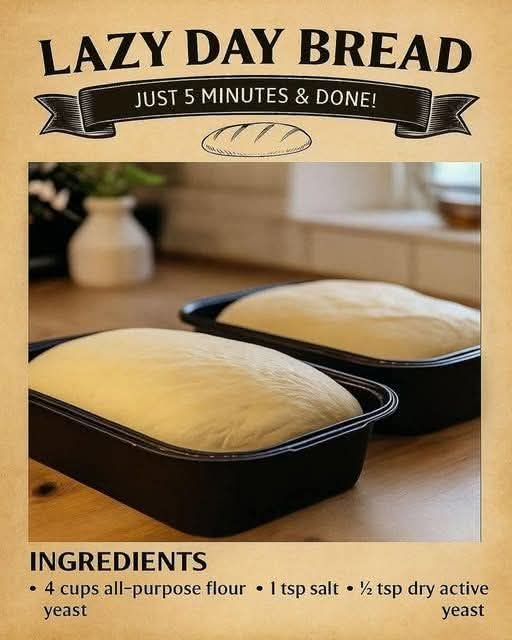🍞 Effortless No-Knead Bread: The Quick Rise Loaf
✨ Introduction: Fresh Bread Made Simple
This recipe revolutionizes home baking by eliminating the most labor-intensive step: kneading. Designed for beginners and busy cooks alike, this **Quick Rise No-Knead Bread** delivers a beautiful, tender loaf with minimal hands-on time. It’s the perfect solution for satisfying that craving for warm, fresh-baked bread without complex techniques. The magic lies in the high hydration and the simple process of allowing the yeast to do all the work, creating gluten structure naturally.
📜 History of No-Knead Baking
While bread making is ancient, the modern **no-knead movement** was popularized by baker **Jim Lahey** of Sullivan Street Bakery in New York City in the mid-2000s. His technique focused on extremely long, slow fermentation (up to 18 hours) to develop maximum flavor and texture. This adaptation, the **Quick Rise** version, speeds up the process by using a warmer liquid and slightly more yeast, making it a functional, delicious loaf ready in under 2 hours, perfect for modern convenience.
📝 Ingredients
- 3 cups All-Purpose Flour
- 1 packet (2 ¼ tsp) Active Dry Yeast
- 1 ½ cups Warm Water ($40-45^\circ C$ or $105-115^\circ F$)
- 1 tsp Salt
- 1 tbsp Granulated Sugar
- 1 tbsp Vegetable Oil or Olive Oil
👩🍳 Instructions & Methods
Follow these simple steps for a flawless loaf:
- Activate the Yeast (Blooming): In a large mixing bowl, combine the **warm water**, **yeast**, and **sugar**. Stir gently and let it sit undisturbed for about 5 minutes. The mixture should become visibly foamy and bubbly, indicating the yeast is active.
- Mix the Dough: Add the **flour**, **salt**, and **oil** to the yeast mixture. Use a spoon or spatula to stir the ingredients until they are just combined. The resulting dough will be shaggy, sticky, and wet—this is crucial for the no-knead texture.
- The “No Kneading” Method: Do not attempt to knead the dough. The long, gentle mixing action and the subsequent rest period (rising) allow the water to fully hydrate the flour, naturally forming the necessary **gluten structure** without manual effort. Simply ensure all the dry flour is incorporated.
- First Rise (Bulk Fermentation): Cover the bowl tightly with plastic wrap or a kitchen towel. Let the dough rise in a warm, draft-free place for approximately **30–45 minutes**, or until the dough has visibly doubled in size.
- Shape & Pan: Lightly grease a standard loaf pan (approximately $9 \times 5$ inches). Gently scrape the dough out of the bowl and shape it minimally into a loaf shape—just enough to fit the pan. Place it into the prepared pan(s).
- Bake: Preheat your oven to **$375^\circ F$ ($190^\circ C$)**. Place the pan into the preheated oven and bake for **25–30 minutes**. The bread is done when the crust is golden brown and sounds hollow when tapped.
- Cool & Enjoy: Immediately remove the bread from the pan and let it cool slightly on a wire rack. Slice and enjoy warm, perhaps with a generous spread of butter or jam.
🔬 Formation & Benefits
Formation (The Science of the Loaf)
The success of this recipe hinges on the **Hydration Method**:
- Gluten Development: In traditional bread, kneading stretches and aligns gluten strands. In this method, the high water content and the yeast’s production of carbon dioxide allow the **gluten strands to relax and align naturally** during the long resting period.
- Yeast Activation: The sugar feeds the yeast in the warm water, producing $\text{CO}_2$ (the foam) which leavens the bread and contributes to its rise and airy texture.
Benefits
This recipe offers significant advantages:
- Time Saving: Less than 5 minutes of active, hands-on mixing time.
- Guaranteed Success: Highly forgiving and perfect for new bakers.
- Energy: Provides essential complex carbohydrates and dietary fiber (depending on flour type).
❤️ Conclusion & Lovers
This **Effortless No-Knead Loaf** demystifies bread making, proving that anyone can enjoy the rich aroma and satisfying taste of homemade bread. It requires minimal technique and yields maximum reward. It is cherished by:
| Lover Group | Reason for Love |
|---|---|
| The Beginner Baker | Minimal failure points; no complicated kneading technique required. |
| The Busy Professional | The short active time fits easily into a hectic schedule. |
| The Comfort Seeker | The simple, rustic flavor and soft texture are deeply comforting. |
This simple bread is the perfect accompaniment to soups, stews, or simply toasted for breakfast, making it a beloved staple in any home.
